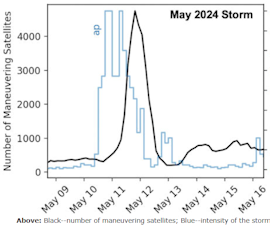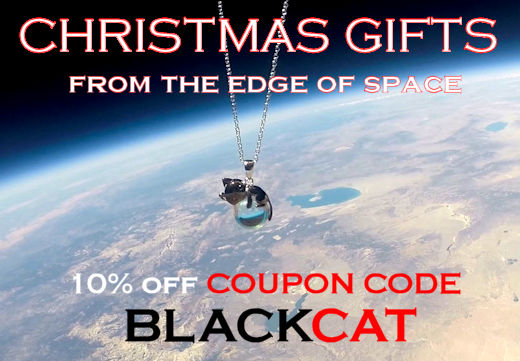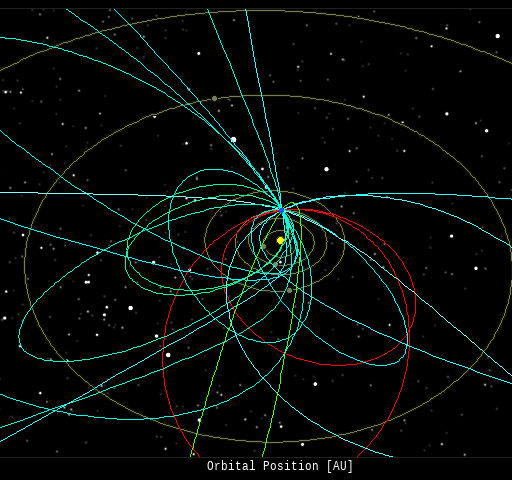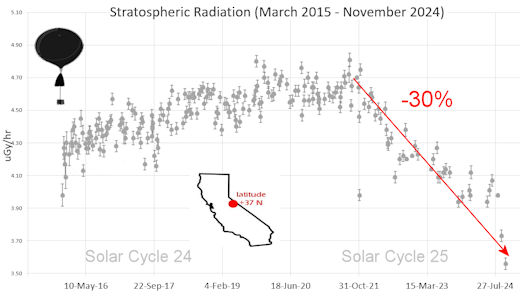This is an AI Free Zone: Text created by Large Language Models is spreading across the Internet. It's well-written, but frequently inaccurate. If you find a mistake on Spaceweather.com, rest assured it was made by a real human being. | | |
A HOLE IN THE SUN'S ATMOSPHERE: A hole in the sun's atmosphere is directly facing Earth, and it is spewing a stream of high-speed solar wind in our direction. Minor G1-class geomagnetic storms are possible on Dec. 24th when the gaseous material arrives. Arctic sky watchers should be alert for Christmas Lights. Aurora alerts: SMS Text.
ORBITAL HOUSE OF CARDS: Earth’s orbital environment has become dangerously fragile. A new study led by Sarah Thiele of Princeton University warns that if satellite collision-avoidance systems were knocked offline by a major solar storm, a catastrophic collision in low-Earth orbit could occur in as little as 2.8 days.

Researchers call this ticking countdown the
CRASH Clock (short for Collision Realization And Significant Harm). It measures how long it would take, on average, for a debris-producing collision to occur if satellites suddenly lost situational awareness and stopped maneuvering.
In 2018, before today’s megaconstellations filled the skies, the CRASH Clock stood at 121 days. Today, it’s less than three.
Orbital traffic is now at unprecedented levels, especially in dense shells of Starlink spacecraft near 550 km altitude. The study shows that close encounters between space objects happen every 20 seconds across low-Earth orbit. According to SpaceX’s most recent biannual report, Starlink satellites alone executed 144,404 collision-avoidance maneuvers between Dec. 1, 2024, and May 31, 2025.
At the best of times, avoiding collisions requires constant, precise maneuvering. But what would happen if satellite operators no longer knew exactly where their spacecraft were?
 That scenario is not hypothetical. During the geomagnetic superstorm of May 10-11, 2024, more than 5,000 satellites made emergency maneuvers to maintain their orbits (full story). Most were Starlinks. Position uncertainties grew to kilometers--exactly the kind of disruption envisioned by the CRASH Clock. Fortunately, the storm subsided before a major collision occurred.
That scenario is not hypothetical. During the geomagnetic superstorm of May 10-11, 2024, more than 5,000 satellites made emergency maneuvers to maintain their orbits (full story). Most were Starlinks. Position uncertainties grew to kilometers--exactly the kind of disruption envisioned by the CRASH Clock. Fortunately, the storm subsided before a major collision occurred.
Satellite operators have long feared a doomsday scenario called the Kessler Syndrome--a runaway cascade of satellite destruction triggered by a single debris-producing impact. This paper argues we may not be in a Kessler cascade yet, but we are operating in conditions where one bad solar storm or software failure could start the CRASH Clock ticking.
Enjoy your Starlink--while you can.
Realtime Space Weather Photo Gallery
Free: Spaceweather.com Newsletter
CHRISTMAS GIFTS FROM THE STRATOSPHERE: Christmas is coming. Are you looking for a far-out gift? Check out the Earth to Sky Store. It's filled with items that have visited the edge of space onboard cosmic ray research balloons:

Earth to Sky gifts have flown above 99.7% of Earth's atmosphere, experiencing space-like blasts of cosmic rays, extreme cold, and a wild ride parachuting back to Earth after the balloon explodes. Even Amazon doesn't carry items this far out.
Don't forget to enter coupon code "BLACKCAT" at checkout for a 10% holiday discount.
Far Out Gifts: Earth to Sky Store
All sales support hands-on STEM education
Realtime Comet Photo Gallery
Free: Spaceweather.com Newsletter
Realtime Aurora Photo Gallery
Free: Spaceweather.com Newsletter
Every night, a network of
NASA all-sky cameras scans the skies above the United States for meteoritic fireballs. Automated software maintained by NASA's Meteoroid Environment Office calculates their orbits, velocity, penetration depth in Earth's atmosphere and many other characteristics. Daily results are presented here on Spaceweather.com.
On Dec. 20 2025, the network reported 16 fireballs.
(14 sporadics, 2 Dec. Leonis Minorids)

In this diagram of the inner solar system, all of the fireball orbits intersect at a single point--Earth. The orbits are color-coded by velocity, from slow (red) to fast (blue). [Larger image] [movies]
Potentially Hazardous Asteroids (
PHAs) are space rocks larger than approximately 100m that can come closer to Earth than 0.05 AU. None of the known PHAs is on a collision course with our planet, although astronomers are finding
new ones all the time.
On December 20, 2025 there were 2349 potentially hazardous asteroids.
 |
Recent & Upcoming Earth-asteroid encounters: | Asteroid | Date(UT) | Miss Distance | Velocity (km/s) | Diameter (m) |
| 2025 TZ | 2025-Dec-15 | 17.8 LD | 6.2 | 53 |
| 2025 YD | 2025-Dec-15 | 5.4 LD | 6.5 | 10 |
| 2025 WA14 | 2025-Dec-15 | 20 LD | 9.3 | 36 |
| 2025 XX2 | 2025-Dec-15 | 2.4 LD | 8.2 | 11 |
| 2016 YH | 2025-Dec-15 | 7.6 LD | 8.8 | 28 |
| 2025 YJ1 | 2025-Dec-15 | 19.8 LD | 13.7 | 47 |
| 2025 WA3 | 2025-Dec-15 | 8.9 LD | 19.4 | 253 |
| 2025 XN4 | 2025-Dec-16 | 0.5 LD | 14.8 | 12 |
| 2025 YQ1 | 2025-Dec-16 | 10.8 LD | 15.5 | 22 |
| 2025 YY1 | 2025-Dec-16 | 10.5 LD | 14.8 | 37 |
| 2025 YS1 | 2025-Dec-16 | 3.6 LD | 9.2 | 6 |
| 2025 YN1 | 2025-Dec-16 | 9.1 LD | 13.7 | 22 |
| 2025 XP4 | 2025-Dec-17 | 14 LD | 8 | 30 |
| 2025 XJ2 | 2025-Dec-17 | 5.7 LD | 12 | 20 |
| 2025 YE1 | 2025-Dec-17 | 2 LD | 12.5 | 6 |
| 2025 WD4 | 2025-Dec-17 | 19.9 LD | 12.7 | 45 |
| 2025 YC | 2025-Dec-17 | 1.9 LD | 7.4 | 4 |
| 2025 WN6 | 2025-Dec-17 | 15.9 LD | 2.9 | 37 |
| 2025 YW | 2025-Dec-17 | 3.2 LD | 14.3 | 17 |
| 2025 YP1 | 2025-Dec-17 | 7.5 LD | 13.3 | 9 |
| 2025 YN | 2025-Dec-17 | 18.2 LD | 13.1 | 20 |
| 2025 YT | 2025-Dec-18 | 1.9 LD | 10 | 14 |
| 2025 XV | 2025-Dec-18 | 6.8 LD | 9.5 | 91 |
| 2025 YL1 | 2025-Dec-18 | 1.6 LD | 24.4 | 8 |
| 2025 XQ5 | 2025-Dec-18 | 15.3 LD | 6.8 | 31 |
| 2025 YG | 2025-Dec-18 | 13 LD | 15.3 | 38 |
| 2025 XR5 | 2025-Dec-18 | 14.7 LD | 17.6 | 52 |
| 2015 XX168 | 2025-Dec-18 | 6 LD | 11.4 | 27 |
| 2025 XV3 | 2025-Dec-19 | 14.7 LD | 15 | 53 |
| 2025 XQ3 | 2025-Dec-19 | 9 LD | 15.1 | 35 |
| 2025 YG1 | 2025-Dec-20 | 5.2 LD | 9.7 | 14 |
| 2025 XV1 | 2025-Dec-20 | 16.9 LD | 7.8 | 24 |
| 2010 WR7 | 2025-Dec-20 | 19.4 LD | 8.3 | 71 |
| 2025 XT4 | 2025-Dec-20 | 6.6 LD | 6 | 10 |
| 2025 XC4 | 2025-Dec-20 | 14.6 LD | 9.6 | 23 |
| 2025 XX4 | 2025-Dec-20 | 16.7 LD | 5.9 | 25 |
| 2025 YF | 2025-Dec-21 | 10.6 LD | 7.7 | 35 |
| 2025 XQ6 | 2025-Dec-21 | 11.4 LD | 11.6 | 45 |
| 2025 XH6 | 2025-Dec-21 | 6.4 LD | 13.4 | 14 |
| 2025 WT3 | 2025-Dec-22 | 16 LD | 4.5 | 26 |
| 2025 YU | 2025-Dec-22 | 15.1 LD | 8.8 | 24 |
| 2025 YY | 2025-Dec-23 | 2.6 LD | 11.9 | 28 |
| 2025 XN5 | 2025-Dec-25 | 11.3 LD | 15.5 | 49 |
| 2025 XP3 | 2025-Dec-26 | 13.3 LD | 13.5 | 55 |
| 2025 XJ4 | 2025-Dec-27 | 14.4 LD | 6.7 | 37 |
| 2025 YJ | 2025-Dec-28 | 18.7 LD | 7.4 | 19 |
| 2021 AB1 | 2025-Dec-28 | 10.2 LD | 12.3 | 16 |
| 2019 AU | 2025-Dec-30 | 19.3 LD | 2.8 | 16 |
| 2024 AV2 | 2025-Dec-30 | 17.9 LD | 7 | 17 |
| 2025 XC7 | 2026-Jan-01 | 8.9 LD | 6.6 | 28 |
| 2025 YZ | 2026-Jan-02 | 14.1 LD | 6.7 | 29 |
| 2014 AF16 | 2026-Jan-04 | 9 LD | 9.6 | 34 |
| 2025 YV1 | 2026-Jan-05 | 11.8 LD | 16.4 | 50 |
| 2025 XS4 | 2026-Jan-06 | 8 LD | 6.5 | 24 |
| 2023 XM15 | 2026-Jan-07 | 15.2 LD | 6.9 | 51 |
| 2025 YL | 2026-Jan-12 | 7.7 LD | 3.9 | 13 |
| 2022 GR3 | 2026-Jan-12 | 14.5 LD | 12.9 | 9 |
| 2025 XN1 | 2026-Jan-14 | 9.3 LD | 4.7 | 36 |
| 2022 OB5 | 2026-Jan-14 | 1.7 LD | 2.2 | 6 |
| 2025 BL | 2026-Jan-17 | 4.7 LD | 6.9 | 28 |
| 2004 MO3 | 2026-Jan-17 | 17 LD | 10.2 | 129 |
| 2011 AM37 | 2026-Jan-17 | 19.8 LD | 5.1 | 4 |
| 2019 LZ4 | 2026-Jan-23 | 14.2 LD | 11.6 | 45 |
| 2025 YR1 | 2026-Jan-27 | 19.5 LD | 4.1 | 29 |
| 2022 AG | 2026-Jan-29 | 13.7 LD | 5.3 | 34 |
| 2020 GE | 2026-Jan-29 | 16.2 LD | 1.2 | 8 |
| 2023 RX1 | 2026-Jan-31 | 8.8 LD | 1.2 | 3 |
| 2022 OC3 | 2026-Jan-31 | 1.3 LD | 3.8 | 8 |
| 2021 CZ5 | 2026-Feb-09 | 18.3 LD | 9.3 | 23 |
| 2025 CC | 2026-Feb-09 | 17.6 LD | 5.1 | 11 |
| 2019 CN2 | 2026-Feb-11 | 20 LD | 9.2 | 7 |
| 2022 DV | 2026-Feb-12 | 15.4 LD | 5 | 18 |
| 1999 AO10 | 2026-Feb-13 | 10.5 LD | 2.7 | 59 |
| 162882 | 2026-Feb-14 | 17 LD | 19.2 | 626 |
Notes: LD means "Lunar Distance." 1 LD = 384,401 km, the distance between Earth and the Moon. 1 LD also equals 0.00256 AU. | | Cosmic Rays in the Atmosphere |
SPACE WEATHER BALLOON DATA: Almost once a week, Spaceweather.com and the students of Earth to Sky Calculus fly space weather balloons to the stratosphere over California. These balloons are equipped with sensors that detect secondary cosmic rays, a form of radiation from space that can penetrate all the way down to Earth's surface. Our monitoring program has been underway without interruption for 10 years, resulting in a unique dataset of in situ atmospheric measurements.
Latest results (Nov. 2024): Atmospheric radiation is sharply decreasing in 2024. Our latest measurements in November registered a 10-year low:

What's going on? Ironically, the radiation drop is caused by increasing solar activity. Solar Cycle 25 has roared to life faster than forecasters expected. The sun's strengthening and increasingly tangled magnetic field repels cosmic rays from deep space. In addition, solar coronal mass ejections (CMEs) sweep aside cosmic rays, causing sharp reductions called "Forbush Decreases." The two effects blend together to bring daily radiation levels down.
.Who cares? Cosmic rays are a surprisingly "down to Earth" form of space weather. They can alter the chemistry of the atmosphere, trigger lightning, and penetrate commercial airplanes. According to a study from the Harvard T.H. Chan school of public health, crews of aircraft have higher rates of cancer than the general population. The researchers listed cosmic rays, irregular sleep habits, and chemical contaminants as leading risk factors. A number of controversial studies (#1, #2, #3, #4) go even further, linking cosmic rays with cardiac arrhythmias and sudden cardiac death.
Technical notes: The radiation sensors onboard our helium balloons detect X-rays and gamma-rays in the energy range 10 keV to 20 MeV. These energies span the range of medical X-ray machines and airport security scanners.
Data points in the graph labeled "Stratospheric Radiation" correspond to the peak of the Regener-Pfotzer maximum, which lies about 67,000 feet above central California. When cosmic rays crash into Earth's atmosphere, they produce a spray of secondary particles that is most intense at the entrance to the stratosphere. Physicists Eric Regener and Georg Pfotzer discovered the maximum using balloons in the 1930s and it is what we are measuring today.
| | The official U.S. government space weather bureau |
| | The first place to look for information about sundogs, pillars, rainbows and related phenomena. |
| | Researchers call it a "Hubble for the sun." SDO is the most advanced solar observatory ever. |
| | 3D views of the sun from NASA's Solar and Terrestrial Relations Observatory |
| | Realtime and archival images of the Sun from SOHO. |
| | information about sunspots based on the latest NOAA/USAF Active Region Summary |
| | current counts of failed and deployed Starlink satellites from Jonathan's Space Page. See also, all satellite statistics. |
| | Authoritative predictions of space junk and satellite re-entries |
| | from the NOAA Space Environment Center |
| | fun to read, but should be taken with a grain of salt! Forecasts looking ahead more than a few days are often wrong. |
| | from the NOAA Space Environment Center |
| | the underlying science of space weather |
 | Got a chipped or cracked windshield that prevents you from seeing space weather events while driving? Get windshield replacement from SR Windows & Glass with free mobile auto glass service anywhere in the Phoenix area. |
| | These links help Spaceweather.com stay online. Thank you to our supporters! |
| | | | | | |

